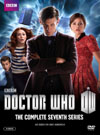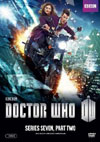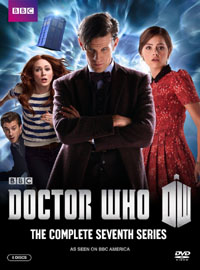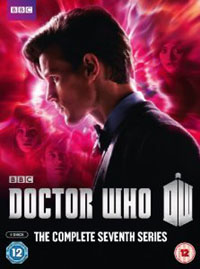DVD Extras for this story on the 15-episode box sets include:
Meanwhile, what it doesn't do is to give the viewer any indication that it will branch out into other more worthy areas later on. That sense of anticipation that can drive a story forward isn't really here.
When this does turn into a time-pressured action-based interdimensional rescue operation, it pretty much dispels its grip on the supernatural genre.... making one question why it bothered to build that tone so strongly at the beginning. The story goes to a lot of trouble setting up the idea that the woman trapped in the pocket universe is moving at a radically different rate of time than the rest of us.... and yet this later has no bearing whatsoever on all the various jumps in and out of the pocket universe. How is the Doctor able to jump in, run all over the place with the woman, and have her exit that universe in 1974, when running one step would take her a millennium of our time, and we already saw that she spent our contemporary century running alone? The fact that all that screen time spent exploring the time difference is then casually tossed off, with neither the writer nor the characters nor the director and crew seeming to care really puts me off of the story. It is also said that the ghost phenomenon can only be photographed in the presence of a psychic like Emma, and that objective pieces of equipment on their own detect nothing. That seems to reflect a lot of true life reports of similar phenomena. But how then can the Doctor take so many photos of the ghost all across time without taking Emma with him on the journey? Chalk up one more story point that the writer doesn't seem to have thought through very well. I'm also a bit turned off by cinematic dramas that try to heighten "the pain factor" experienced by characters like Emma Grayling when they perform some kind of grand psychic stunt, particularly when all my experience of such things indicates that quieting the physical world and all sensations from it is critical to achieving the mental focus and frequency necessary to create any kind of otherworldly links. Thus a cheap stunt for dramatics winds up being very counterproductive to the story's believability, on top of making unpleasant viewing. The strategies employed during the rescue also wind up working against themselves. Early on, the Doctor gives a good reason why the TARDIS can't/shouldn't pop into the alternate universe to perform the rescue, and why he then prefers to have Emma open up a wormhole through her psychic link, even though that also is supposed to be quite dangerous. Okay, all fine and dandy. But then the tale loses significant coherence when both strategies are employed in tandem. Isn't that too much of an unnecessary risk? Can the team not do a better job of figuring out which risk to take, and just do one at a time? I'm really unclear why we needed both together, and the conclusion to this story feels unnecessarily exhausting. It's also strikingly bizarre that the TARDIS would have the conversation that it does with Clara, via an outside projection... mostly because the only other time it's done something similar back in the one where Vultures Circle, the Doctor had to carefully coax such behaviour out of it from the console room, and it was barely conversational. If it was capable of offering this much information and banter, many other more dire circumstances might have had greater need for it. It simply feels like clumsy scripting here, as though the Doctor could have said all of this were he here, but not having anyone else to talk to, Clara had to get this info-dump from the TARDIS itself. A scene of her reading it from a console computer monitor, as Tegan had to in "Castrovalva" (story no. 117), would have made much better sense and kept the TARDIS more in character.
"This isn't a ghost story; it's a love story."I do like the love story direction that this adventure chose to move towards in its later stages - it is more my cup of tea than the fearful side of the supernatural for sure. The story draws obvious parallels between the professed partnering of Emma and Alec Palmer and the partnering of the Doctor and Clara, which is all quite cute and adds some humorous and touching moments throughout the adventure, becoming one of its highlights.There's also a nice thread running beneath the surface, in that Emma and the Doctor seem to have a prior relationship that they keep hidden from the other characters, giving some of Emma's dialogue with Alec a few double meanings. Nice. Ultimately this is one more element used to serve the ongoing arcs of Season 33, which this story indulges in. The Doctor is still unsure of who or what Clara is. The TARDIS doesn't seem to trust her either, a conflict that comes to a head in the next story. Much of this is even more striking when you find out that "Hide" was written and shot well before the three stories that preceded it in broadcast story order. Matt Smith's choice to do his first Doctor Who commentary on this story proves to be worthwhile, as it actually was a beginning point for many aspects of the season, including Clara's character. Tune in to find out more....
Crooked CodaThe ultimate disjointing of this adventure comes right at the end. Just when you think there might be enough worthwhile sense to this story, it collapses in on itself once more.Theoretically, the "crooked man" creature is a great concept. The design and movement work wonderfully, and its context in the story as a shadowy unknown creeping through the interdimensional foggy forest, poking through into the haunted house, is all great stuff. Its actual contribution to the narrative wasn't that great though, simply slotting in for that thing that characters run away from while the plot is all about other things. I rolled my eyes when the woman said there was something in that dimension with her. Yes of course, isn't there always? The Doctor prescribes running. Ho hum. A good exploration of this creature was sorely lacking.
Okay, I'm not heartless enough to say that the Doctor shouldn't strive to help weird creatures have a happy ending. But even with that in mind, would it not be a better ending to send the other crooked creature back to the funky dimension, the natural habitat I assume it originally came from? (See, this is why you need to explore the creature properly first.) Do we want to have two of these creatures here in England 1974, mating and breeding more of themselves? Nothing has been done in this story to establish their motives or temperament, and we've no reason yet to believe that they are benign, or that they won't run amok like the Big Foot creature in "Harry and the Hendersons". Is the crooked creature the source of all that melodramatic evil laughter in the misty forest? If so, how can we reconcile that with a creature that just wanted to reunite with its mate? Or was the pocket universe just responding to the Doctor's thoughts, reflecting his expectations of evil mockery with an audible external laugh? Whatever concept Neil Cross has in his mind (or in his stage directions) for these creatures' real motivation, it hasn't been properly conveyed to the viewer or made consistent nearly well enough for us to get on board emotionally with his surprise "ending". I do, however, love that shot near the end when the Doctor finally gets a good look at the creature's face - good design work there. The clumsy way that the last 90 seconds or so of this story are chucked at us, tearing down what's left of the adventure's logic and tone structure, really knocked the whole story down a couple more notches in the season's ranking. And at the end of the day, I'm really not sure what the story's title is all about. It feels as clumsy as "Fear Her", as though it's an instruction to the audience about what they should do or feel. It really is a shame, because I have enjoyed other stories that start out as supernatural "horror" before morphing into interdimensional intrigue. Two examples that I rate fairly highly would be "The Stones of Blood" (story no. 100), and the season four Sliders episode "The Alternateville Horror". Both of these sported better logic and more consistent tones and/or more controlled shifts in tone. The problem-solving threads that the characters invested themselves in were noticeably stronger, making it easier for the audience to get emotionally invested as well. Even though "The Stones of Blood" had a bit of trouble creating anticipation and drive at the beginning, it still benefitted by being surrounded by a greater abundance of spacey settings in the surrounding stories, and like all of the adventures in the Key to Time season, had that extra intrigue up front from the Doctor's ongoing mission and search.
International Titles:Deutsch: "Geisterjagd"Magyar: "Rejtek"Français: "Le Fantôme de Caliburn"Русский: "Прячься"Italiano: "Universo nascosto"Well, I'm no fan of the English title on this one, so bring on the variations. The Germans found a cool one, meaning "Ghost Hunt". The French title "The Phantom of Caliburn" also packs a nice punch. The Italians went for "Hidden Universe" ...okay, one of my favourite concepts, but doesn't that give away too much too soon? Then again, perhaps this episode's early sections need that extra anticipation to draw some viewers along....
This story has become available on DVD and Blu-ray.
This story is also available in an 8-episode volume with minimal extra features. The U.K. version also includes the episode "The Snowmen"; North American versions do not. Click on the Amazon symbol for the location nearest you for pricing and availability:
Comments on this article are welcome. You may contact the author from this page:
|
||||||||||||||||||||||||||||||||||||||||||||||||||||||














